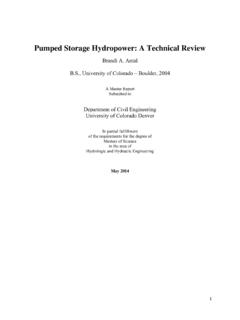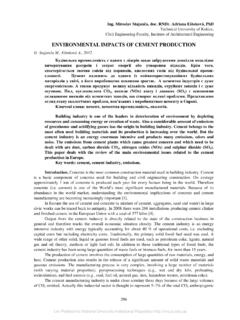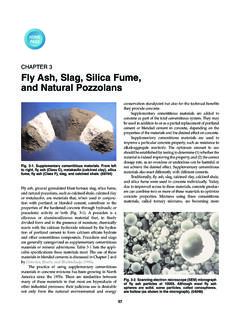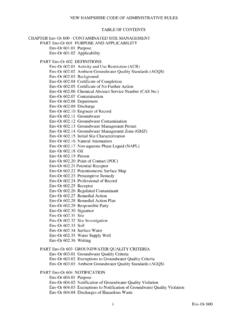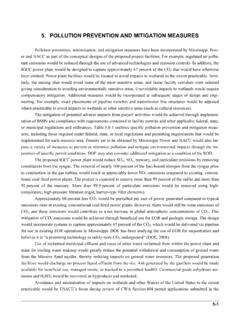Transcription of National Methodology and Emission Inventory for ...
1 A National Methodology and Emission Inventory for residential fuel combustion Bernd H. Haneke PES, Inc. (A MACTEC Company). 5001 South Miami Boulevard, Ste. 300. Research Triangle Park, NC 27709. E-mail: ABSTRACT. The 1999 National Emission Inventory (NEI) contains State-reported area source residential fuel combustion Emission estimates. The approaches and methodologies used to develop residential fuel combustion Emission inventories are not consistent among States. Therefore, the emissions reported to the NEI by States are not consistent or compatible. In response to this, an innovative Methodology was developed and funded by the emissions Inventory Improvement Program (EIIP) to calculate consistent residential fuel combustion criteria pollutant emissions on a National , state, and county level for the following fuels: natural gas, liquefied propane gas, kerosene, fuel oil, anthracite and bituminous coal.
2 Once apportioned to the county level, emissions were calculated by multiplying the fuel consumption by the applicable Emission factors. This approach provides for a consistent residential fuel combustion Emission Inventory . Furthermore, the Methodology allows for easy future updates of fuel consumption and census data. In summary, this approach and Methodology provides an efficient mechanism for calculating residential fuel combustion emissions on the State and county level for the United States and can be used for future NEI development efforts. INTRODUCTION. This project, funded by the emissions Inventory Improvement Program (EIIP) and administered by the United States' Environmental Protection Agency (EPA) Emission Factor Inventory Group (EFIG) had a two- fold goal: to analyze the reported residential fuel combustion emissions estimates in the 1999 NEI (version 2), and to develop a method for estimating residential fuel combustion emissions on a State and county level for the whole nation.
3 State- level emissions comparisons were developed to show the differences between NEI reported emissions and emissions estimates developed for this project. The draft 1999 National emissions Inventory (NEI) contains area source emissions estimates for residential fuel combustion . These Emission estimates are provided to the EPA by individual States. There is no comprehensive National Methodology for calculating emissions from residential fuel combustion . Consequently, the methods used by States for calculating emissions from residential fuel combustion are inconsistent, as are their results. The method developed for estimating residential fuel combustion emissions makes use of publicly available data sets.
4 Separate data sets were obtained for fuel consumption, and for allocating fuel to States and individual counties. Emission factors were obtained from the EPA. Using the data and Emission factors, emissions estimates were prepared for the following criteria pollutants: Carbon monoxide;. Nitrogen oxides;. Sulfur dioxide;. Volatile organic compounds; and, Filterable particulate matter (both PM10 and ) and condensable PM. emissions estimates for all States and counties in the United States were developed in spreadsheets. Due to the size of the individual worksheets, it was not feasible to include copies in table format in this document. A number of screen shots have been included to provide pictures of the individual worksheets.
5 This paper documents the method and results of this project. It is arranged in a sequential order, beginning with a description and explanation of the various data sources. This is followed by a description of the Methodology used to calculate emissions for residential fuel combustion . The results of applying the method are discussed, and conclusions are made regarding the use and validity of the emissions estimates generated by this project. 2. BODY. Data Sources It was imperative that the Methodology used for this project be based on publicly-available data. Therefore, one of our first milestones was to find publicly-available data sources. fuel consumption data for 1999 were obtained from the US Department of Energy's (DOE) Energy Information Administration (EIA).
6 Information on anthracite and bituminous coal consumption was obtained by contacting the DOE's EIA directly. The EIA made anthracite and bituminous coal consumption estimates available for 1999 but indicated that it would be discontinuing its reporting of anthracite coal in the future. Data used to allocate EIA's fuel consumption data to the State and county level were obtained from the US Census Bureau's 1990 Detailed Housing Characteristics data set. The 1990 data set was the only one available during the duration of this project. Emission factors were selected from the EPA's Compilation of Stationary Emission Factors (commonly referred to as AP-42).
7 fuel oil sulfur data were obtained from the 1985 National Acid Precipitation Program (NAPAP) and the Federal Energy Commission's FERC-423 database. Coal sulfur data were obtained from the US Geological Survey's COALQUAL database. Finally, a copy of the draft 1999 version 2 NEI was obtained from the EPA, as were SCCs used to query the NEI database. Selection of Emission Factors An extensive search and review was conducted to identify Emission factors for the fuels and pollutants of concern to this project. The principal source of Emission factors was the EPA's Compilation of Stationary Source Emission Factors, commonly referred to as AP-42. Wherever possible, the most recent release(s) of AP-42 were used.
8 In many cases, residential -specific Emission factors were not available for selected fuel types or heating unit size ranges. Emission factors were then selected based on the heating unit size and firing configuration that most closely matched residential heating units. Therefore, oftentimes commercial/institutional factors were selected. Heating unit size ranges were obtained from an earlier version of AP-42, Section (1996). This section distinguishes among heating unit/boiler sizes in the following manner: Utility/Large Industrial Boilers: >100 MMBtu Small Industrial Boilers: 10 - 100 MMBtu Commercial Boilers: - <10 MMBtu residential Furnaces: < MMBtu.
9 The individual Emission factors that were selected and used for this Emission Inventory are presented in the subsequent tables. 3. Natural Gas Emission factors for residential natural gas combustion were obtained from AP-42, Section Table 1 presents the selected Emission factors for natural gas combustion . Table 1. Emission Factors for residential Natural Gas combustion . Pollutant Emission Factor AP-42 Table Publication (lb/106 ft 3 ) Date CO 40 07/98. NO x 94 07/98. SO2 07/98. VOC 07/98. PM10 (Filterable) 07/98. (Filterable) 07/98. PM Condensable 07/98. All Emission factors are based on natural gas having a heat content of 1,020 Btu/ft3 . The CO. and NOx Emission factors are specific for uncontrolled residential furnaces.
10 The SO2 and VOC. Emission factors are applicable to all units burning natural gas. The SO2 Emission factor assumes that the sulfur content of natural gas is 2,000 grains/106 ft3 . The filterable PM10 and Emission factors are identical as all PM from natural gas combustion is assumed to be less than micrometer in diameter. Liquefied Petroleum Gas (LPG). LPG emissions are considered to be similar to natural gas. Most of the Emission factors were obtained from Section in AP-42. PM10, (condensable and filterable) and VOC Emission factors are the same as those for natural gas; NOx emissions are approximately 50 percent higher than those for natural gas. The SO2 Emission factor is (S) lb/103 gallon of fuel combusted.










